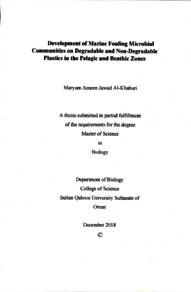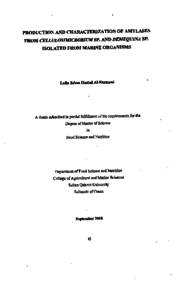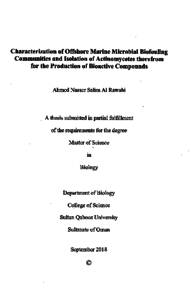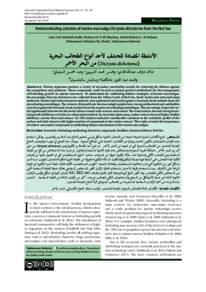Document
Quantitative and qualitative study of microbial biofilms on marine antifouling coatings
Publisher
Sultan Qaboos University
Gregorian
2016
Language
English
English abstract
Marine biofouling is the undesirable accumulation of microorganisms (microfouling) and macro-organisms (macrofouling) on any surfaces immersed in the marine environment. The most common strategy to prevent biofouling includes the use of biocidal and non-biocidal fouling release (FR) antifouling (AF) coatings in the marine environment. Although AF coatings prevent macrofouling, limited information is available on AF efficiency in preventing microfouling in Oman waters. The current study investigated the development of microbial communities on various commercial AF coatings in two marinas in Muscat, Oman. As a preliminary investigation, the current method of estimating bacterial abundances was evaluated counting all fields of view using epifluorescence microscopy. Experiments were conducted to study the short-term (2 weeks) variations in the abundance of fouling bacteria on biocidal and non-biocidal FR antifouling coatings using epifluorescence microscopy in Marina Shangri La and Marina Bandar Rowdha, Muscat. Experiments investigating long-term microfouling were conducted after one year of immersion in both marinas in Muscat. The abundance and composition of fouling bacterial communities was estimated using epifluorescence microscopy and 454 pyrosequencing technology respectively. The abundance and composition of fouling diatom communities was estimated using both light and scanning electron microscopy (SEM) techniques. Counting bacterial cells from a minimum of 20 randomly selected fields of view using epifluorescence microscopy provided a reliable arithmetic mean to estimate the total abundance of bacteria in a sample. In case of short-term experiments, bacterial abundances on biocidal and non-biocidal fouling release coatings varied significantly on a temporal and spatial scale. In case of long-term experiments, the type of biocidal antifouling coatings, biocide composition and experimental location significantly influenced the abundance and composition of fouling bacterial and diatom communities. The bacteria belonging to the genera Maritimimonas and Acaryochloris were identified on cuprous oxide based antifouling coatings for the first time. Adnate, erect, motile and plocon diatom growth forms were dominated on the biocidal antifouling coatings. Hence, the findings of the current research show that the density and diversity of fouling microbial communities developed on antifouling coatings change on a temporal and spatial scale depending on the nature of the antifouling coatings.
Member of
Resource URL
Arabic abstract
الترسبات الحيوية البحرية هي التراكم الغير مرغوب للكائنات الحية المجهرية (الرواسب الدقيقة والكائنات الحية المرئية (الرواسب الكبيرة على أسطح الأجسام المغموسة في مياه البحر. يعد استخدام الطلاءات المقاومة للترسبات الحيوية البحرية بنوعيها سواء الطلاءات المفرزة للمواد السامة والطلاءات الغير مفرزة للمواد السامة ذوات الأسطح الملساء من أكثر الطرق انتشارا للحماية من تكون الترسبات الحيوية البحرية. بالرغم من فعالية الطلاءات المضادة للترسبات الحيوية في منع نمو الكائنات المترسبة الكبيرة، إلا أن المعلومات محدودة جدا عن فعاليتها في منع ترسب الكائنات المترسبة الدقيقة في مياه البيئة البحرية العمانية. هذا البحث استهدف دراسة تطور الترسبات الميكروبيولوجية على العديد من الطلاءات التجارية المضادة للترسبات الحيوية البحرية في مرسئین بمحافظة مسقط في سلطنة عمان. كدراسة مبدئية تم تقدير عدد البكتيريا المتواجدة في كل خانات الشريحة المجهرية الخاصة لتقدير عدد البكتيريا بإستخدام المجهر ذات الإضاءة الفلورية الخلفية. أجريت تجارب الدراسة إختلاف الترسبات البكتيرية على الطلاءات المفرزة للسموم والطلاءات الغير مفرزة للسموم ذوات الأسطح الملساء على المدى القصير (لمدة أسبوعين) في مرسى بندر الروضة ومرسى شانجريلا- بر الجصة في مسقط وذلك بإستخدام مجهر الإضاءة الفلورية الخلفية. أيضا هناك تجارب تم عملها لدراسة الترسبات البكتيرية الدقيقة على الطلاءات على المدى الطويل بعد عام كامل من التعريض الماء البحر. تم تقدير عدد البكتيريا المترسبة بإستخدام مجهر ذات الإضاءة الفلورية الخلفية في حين تم دراسة نوعية التجمعات البكتيرية المتكونة عن طريق تقنية التصنيف التسلسلي الحراري 454. كما تم دراسة نوعيات وكميات الكائنات ثنائية النواة الرسوبية بإستخدام المجهر الضوئي والمجهر الإلكتروني الماسح تقدير عدد البكتيريا في العينات المستخدمة في التجارب عن طريق حساب اعداد البكتيريا المتواجدة في 20 خانة على الأقل من خانات شريحة العد المجهرية والتي تم اختيارها عشوائيا أعطى نتائج موثوقة ذات معنى حسابي التقدير عدد البكتيريا الموجودة في العينات. في التجارب قصيرة المدى، أعداد البكتيريا التي وجدت على أسطح الطلاءات المفرزة للسموم والطلاءات ذات الأسطح الملساء أختلفت بشكل ملحوظ من حيث المقدار الزمني والمكاني. ومن جهة أخرى أوضحت التجارب طويلة المدى أن نوعية الطلاء وتركيبة المادة السامة المفرزة و مكان إجراء التجارب كان لها دور واضح وملحوظ في تباين أعداد وإختلاف أصناف التجمعات البكتيرية والكائنات ثنائية النواة الصغيرة على أسطح الطلاءات. تم إيجاد بكتيريا يصنف نوعها إلى مجموعة البكتيريا ماريتيميموناس (Maritimimonas) و مجموعة أكاريوكلوريس (Acaryochloris) للمرة الأولى على أسطح الطلاءات المحتوية على أكسيد النحاس. أيضا تم إيجاد أنواع مختلفة من الكائنات ثنائية النواة التي تغطي أسطح الطلاءات المفرزة للسموم منها ذات شكل مستقيم ومنها مندمجة مع بعضها ومنها حركية ومنها ثابتة ومتواجدة مع بعض الطحالب. لذلك؛ فإن نتائج هذه الدراسة تبين أن كثافة ونوعية الكائنات الدقيقة الرسوبية المتكونة على أسطح الطلاءات المقاومة للترسبات الحيوية البحرية تختلف باختلاف الوقت والمكان معتمدة في ذلك على طبيعة الطلاءات المستخدمة.
Category
Theses and Dissertations







